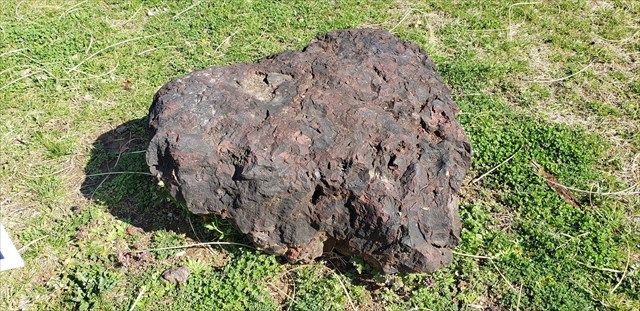This is an Earthcache – as such, there is no physical cache. Instead you will partake in a geology lesson by making observations and answering 5 questions about the bog iron boulders at the near the posted coordinates. This cache is placed in a M-NCPPC Park with permission, so no caching from dusk till dawn.
Iron Minining in Muirkirk
Mining for iron in clay formations was an important industry in central Maryland from the 1600s through the early 1900s. This Dinosaur Park is located on the site of one those 19th-century iron mines. This mine was a part of the Muirkirk ironworks complex that operated from 1874 to the 1920s. African American ironworkers quarried siderite, or iron ore, out of open pit mines. The miners laboriously dug the lumps from the clay, broke them in to smaller pieces, and loaded them on wagons heading to the furnaces.
Iron production slowed and eventually ceased in central Maryland in the early 20th century. The process of melting siderite relied on purchasing charcoal, which was rising in price making it very expensive to purchase. Also during this time, the cost to transport iron ore dropped, making it easier to purchase imported iron. After closing many of these open pit mines remained in use for decades as a source of clay for making brick.

Bog Iron
The Laurel Dinosaur Park falls in a geological area called the Potomac Group . This group is consists of a narrow belt of mostly unconsolidated (not solid), arenaceous (consisting of sand), argillaceous (rocks that consisting of clay), and often ferruginous (containing Iron) sediments of highly varied character that spans Delaware, Maryland, New Jersey, and Virginia. Siderite is common in the Arundel Clays of the Potomac Group.
Iron ores generally consist of several types such as hematite, magnetite, limonite, and siderite. Here at this mine workers mined siderite ore. Siderite is a mineral composed of iron (II) carbonate (FeCO3). It is a valuable iron mineral since it is 48% iron and contains no sulfur or phosphorus.

These bog iron ore boulders are deposits that develop when ground water carrying dissolved iron and manganese through clay or sand reached an oxidized environment like a swamp. It was there that those dissolved metals encountered an "iron bacteria” which caused a chemical reaction. That oxidized iron precipitated and formed a sort of ferruginous cement around the grains of the silt, sand, and clay forming into these ore masses. Repeated fluctuations in the level of the water table added to the thickness of the iron ore.

These masses generally consist of yellowish, brownish, or blackish limonite, usually formed by the influence of micro-organisms, and containing silica, phosphoric acid, and organic matter. It is always porous, often slag like and hard, is usually an irregular aggregate form, but always loose and earthy. It is usually mingled with other substances like humates, iron phosphates, ulmates, crenates, and hydrated iron silicates.
REFERENCES:
1. A Jurassic Discovery, Donald K. Creveling, Parks & Rec Business, May 2, 2013, (PRB), parksandrecbusiness.com
2. Dinosaurs, Iron, and Bricks, Geocache by Moonpie10, October 15, 2010, geocaching.com
3. Dinosaur Park, Bowie Mike, Blog, April 24, 2010, bowieliving.blogspot.com
4. Siderite, Wikipedia, wikipedia.org
5. The Muirkirk Iron Miners, Parks & Recreation, The Maryland-National Capital Park and Planning Commission, mncppcapps.org
6. Potomac Group, including Raritan and Patapsco Formations, Arundel Clay, and Patuxent Formation, U.S. Department of the Interior, Mineral Recources, mrdata.usgs.gov
7. Dinosaur Park, The Maryland-National Capital Park and Planning Commission, pgparks.com
8. Petrology and Origin of Potomac and Magothy [Cretacious] Sediments, Middle Atlntic Coastal Plain, John D. Glaser, Maryland Geological Survey Report of Investigations No.11, 1969, Concretions, Page 36 terpconnect.umd.edu
9. Laurel Dinosaur Park, Atlas Obscura, atlasobscura.com
10. Basic Geology, Kranz, Peter M., Notes on the Sedimentary Iron Ores of Maryland and their Dinosaurian Fauna, atlasobscura.com
11. Report of Iron Ores in Maryland, Tingwald, Joseph T., Maryland Geological and Economic Survey, John Hopkins Press, Baltimore, December 1911, tile.loc.gov
LOGGING REQUIREMENTS:
To log this Earthcache: Read the geology lesson above. Answer all five questions posted below and send them via e-mail or messenger contacts on my Geocaching profile.
QUESTION 1. Siderite is valuable because it contains no sulfur and 48% of what mineral?
QUESTION 2. Observe the bog island boulders on the dirt mound through fence. Do these masses appear to be the same color as the soil that they are resting on or are they much different?
QUESTION 3. Looking at the colors of the bog iron boulders, do you see any yellowish blots of limonite?
QUESTION 4. Rub your hand across one or more of the bog iron boulders. Does the color rub off on your hand or is it pretty well cemented together?
QUESTION 5. Find the sign "The Industrial Heritage of." Under the "History of the Dinosaur Park" it reads "In the 1800s and 1900s, the _____ ______ of Prince Georges County were mined for the mineral siderite, or iron ore." What are the missing words?
OPTIONAL PHOTO: Posting a photo that readily indicates that you (and anyone else logging the find) are at the location.
 Awesnap has earned GSA's highest level:
Awesnap has earned GSA's highest level:
